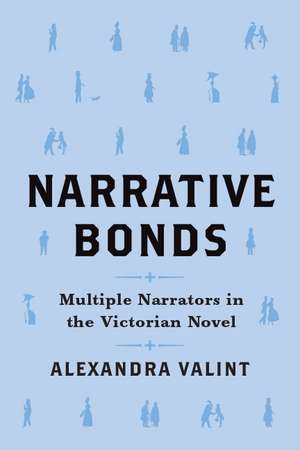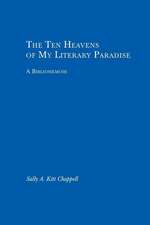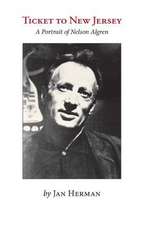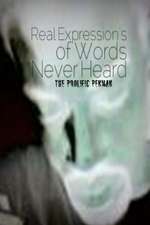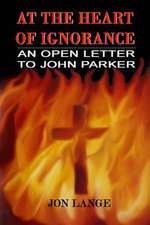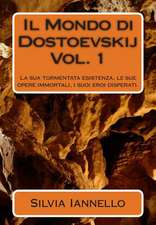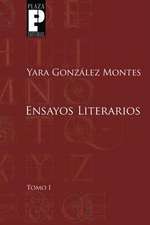Narrative Bonds: Multiple Narrators in the Victorian Novel: Theory and Interpretation of Narrative
Autor Alexandra Valinten Limba Engleză Hardback – 20 ian 2021
While narrative fracturing, multiplicity, and experimentalism are commonly associated with modernist and postmodern texts, they have largely been understudied in Victorian literature. Narrative Bonds: Multiple Narrators in the Victorian Novel focuses on the centrality of these elements and address the proliferation of multiple narrators in Victorian novels. In Narrative Bonds, Alexandra Valint explores the ways in which the Victorian multi-narrator form moves toward the unity of vision across characters and provides inclusivity in an era of expanding democratic rights and a growing middle class. Integrating narrative theory, gothic theory, and disability studies with analyses of works by Charles Dickens, Robert Louis Stevenson, Wilkie Collins, Emily Brontë, and Bram Stoker, this comprehensive and illuminating study illustrates the significance and impact of the multi-narrator structure in Victorian novels.
Din seria Theory and Interpretation of Narrative
-
 Preț: 314.03 lei
Preț: 314.03 lei -
 Preț: 271.17 lei
Preț: 271.17 lei -
 Preț: 346.23 lei
Preț: 346.23 lei -
 Preț: 307.24 lei
Preț: 307.24 lei -
 Preț: 273.46 lei
Preț: 273.46 lei - 23%
 Preț: 473.13 lei
Preț: 473.13 lei -
 Preț: 264.26 lei
Preț: 264.26 lei - 23%
 Preț: 581.06 lei
Preț: 581.06 lei -
 Preț: 258.88 lei
Preț: 258.88 lei - 23%
 Preț: 479.49 lei
Preț: 479.49 lei - 23%
 Preț: 447.95 lei
Preț: 447.95 lei - 23%
 Preț: 470.28 lei
Preț: 470.28 lei - 23%
 Preț: 469.40 lei
Preț: 469.40 lei -
 Preț: 314.03 lei
Preț: 314.03 lei -
 Preț: 274.83 lei
Preț: 274.83 lei - 23%
 Preț: 473.13 lei
Preț: 473.13 lei -
 Preț: 515.99 lei
Preț: 515.99 lei
Preț: 476.07 lei
Preț vechi: 618.27 lei
-23% Nou
Puncte Express: 714
Preț estimativ în valută:
91.11€ • 94.100$ • 75.72£
91.11€ • 94.100$ • 75.72£
Carte tipărită la comandă
Livrare economică 20 martie-03 aprilie
Preluare comenzi: 021 569.72.76
Specificații
ISBN-13: 9780814214633
ISBN-10: 0814214630
Pagini: 224
Dimensiuni: 152 x 229 x 20 mm
Greutate: 0.54 kg
Ediția:1
Editura: Ohio State University Press
Colecția Ohio State University Press
Seria Theory and Interpretation of Narrative
ISBN-10: 0814214630
Pagini: 224
Dimensiuni: 152 x 229 x 20 mm
Greutate: 0.54 kg
Ediția:1
Editura: Ohio State University Press
Colecția Ohio State University Press
Seria Theory and Interpretation of Narrative
Recenzii
“The book offers such a comprehensive and precise catalogue of narratological approaches to the idea of the narrator that even researchers with no interest in the Victorian novel would benefit from Valint's detailed negotiation of narrators, narration, and form.” —Tobias Wilson-Bates, Review 19
“Narrative Bonds both picks up and furthers ongoing narratology scholarship. … Each chapter presents one or more interpretive nuggets that readers will likely delight in having (especially in a classroom context). … Such nuggets are pedagogically useful and occasionally brilliant.” —Christie Harner, Victorian Studies
“Narrative Bonds makes the compelling case that the multi-narrator novel is a distinct animal … [It] also importantly turns our critical attention to the importance of forms besides omniscient narration, [offering] a disruptive counterpoint to omniscient narration’s encompassing vision.” —Shalyn Claggett, Nineteenth-Century Contexts
“The critical framework [Valint] develops in her monograph offers a productive approach to reading dis/ability, gender, privilege, and a host of other critical concerns in Victorian texts that have perhaps become overly familiar,” —Jack M. Downs, Victorian Periodicals Review
“This engaging study of Victorian multi-plot novels makes a compelling argument that, despite the seemingly distinct and potentially disjunctive narrative voices that tell a story, those perspectives cohere in a single worldview, one that points to the middle class’s acquisition of cultural and political power and the period’s gradual movement toward a more democratic state. Valint’s book will be welcomed not only by scholars of Victorian literature but also by those interested more broadly in narrative theory.” —Elizabeth Langland, author of Telling Tales: Gender and Narrative Form in Victorian Literature and Culture
“Valint’s study is a valuable piece of scholarship for the study of multinarrative novels in the nineteenth century, and both Victorianists and narratologists can benefit from it. … Victorian multinarrative novels raised issues of community, collaboration, reliability, power dynamics, and more, and Valint’s book is an excellent study on how form shapes content.” —James Hamby, DIEGESIS
Notă biografică
Alexandra Valint is Associate Professor in the English Program at the University of Southern Mississippi at the University of Southern Mississippi.
Extras
Previous scholarship on Victorian female narrators incidentally addresses multinarrator novels since many of the Victorian period’s female narrators are found therein, but such work overstates either these narrators’ limitations or power. Alison A. Case illuminates the gendered power dynamics of the eighteenth- and nineteenth-century novel: “A feminine narrator typically provides only the raw material of narrative, which is usually shaped and given meaning by a male ‘master-narrator’ within the text, or by an authorial or editorial frame” (13). To Case, therefore, male narrators possess greater narratorial power than female narrators. N. M. Jacobs comes to a similar conclusion, claiming that both Emily Brontë’s Wuthering Heights and Anne Brontë’s The Tenant of Wildfell Hall are framed by privileged male narrators who structurally “cover[ ]” the female narrators, “those without power” (207). The opposite is true to Lisa Sternlieb, who argues that the seeming artlessness of female narrators functions as a smokescreen for their manipulations: “They achieve power” over the greedy men who aim to possess their writings “not through what they do, but through how they tell” (4). Although I agree that tensions and inequalities between narrators exist, particularly between female and male narrators, these arguments overlook the collaboration, unity, and agreement among narrators despite such friction and differences.
...
Victorian authors and thinkers often portrayed collective action negatively, particularly for its presumed tendency to eradicate individual will. Collective action occurred frequently during the period: the Chartist agitation in the late 1830s and 1840s; the demonstrations pushing for the Reform Bill in the mid- to late-1860s; and other strikes and riots (including “Bloody Sunday” in 1887). In Dickens’s Hard Times, written at least partially in response to a strike he visited in Preston, the unionizing and striking workers (known as the “Hands”) are all portrayed as succumbing, hypnosis-like, to the demagogue leader Slackbridge. In defending Stephen Blackpool’s refusal to join the union and crowd, his friend Rachael plaintively asks, “Can a man have no soul of his own, no mind of his own?” (233). Dickens illustrates how individuality—soul, mind, free will—is quashed by the unthinking, violent mass. Nicholas Visser confirms that crowds often were depicted as irrational, dangerous, and animalistic in novels by Dickens, George Eliot, and Benjamin Disraeli. Gustave Le Bon’s “The Mind of Crowds” (1895) posits that when an individual joins a crowd, “he is no longer himself” (60): He “act[s] in a manner quite different from that in which each individual . . . would feel, think, and act were he in a state of isolation” (57). Once the “collective mind is formed” (55), the individual “los[es] his conscious personality” (59) and becomes vulnerable to the “contagion” of other crowd members’ emotions (60). While the Victorian multinarrator novel values the collaboration inherent in the collective narrative, it also shows concerns about forced collaboration and the collective’s sway over the individual. Gothic multinarrator novels like A Beleaguered City manifest the greatest anxiety over the risky or even detrimental effects of collaboration, as I further analyze in chapter 5 and the epilogue.
...
Victorian authors and thinkers often portrayed collective action negatively, particularly for its presumed tendency to eradicate individual will. Collective action occurred frequently during the period: the Chartist agitation in the late 1830s and 1840s; the demonstrations pushing for the Reform Bill in the mid- to late-1860s; and other strikes and riots (including “Bloody Sunday” in 1887). In Dickens’s Hard Times, written at least partially in response to a strike he visited in Preston, the unionizing and striking workers (known as the “Hands”) are all portrayed as succumbing, hypnosis-like, to the demagogue leader Slackbridge. In defending Stephen Blackpool’s refusal to join the union and crowd, his friend Rachael plaintively asks, “Can a man have no soul of his own, no mind of his own?” (233). Dickens illustrates how individuality—soul, mind, free will—is quashed by the unthinking, violent mass. Nicholas Visser confirms that crowds often were depicted as irrational, dangerous, and animalistic in novels by Dickens, George Eliot, and Benjamin Disraeli. Gustave Le Bon’s “The Mind of Crowds” (1895) posits that when an individual joins a crowd, “he is no longer himself” (60): He “act[s] in a manner quite different from that in which each individual . . . would feel, think, and act were he in a state of isolation” (57). Once the “collective mind is formed” (55), the individual “los[es] his conscious personality” (59) and becomes vulnerable to the “contagion” of other crowd members’ emotions (60). While the Victorian multinarrator novel values the collaboration inherent in the collective narrative, it also shows concerns about forced collaboration and the collective’s sway over the individual. Gothic multinarrator novels like A Beleaguered City manifest the greatest anxiety over the risky or even detrimental effects of collaboration, as I further analyze in chapter 5 and the epilogue.
Cuprins
Contents Acknowledgments Introduction Unity and Reliability in the Victorian Multinarrator Novel Chapter 1 Epistles to Narratives to Monologues Chapter 2 Depth and Surface: Back-and-Forth Narration and Embodiment in Bleak House Chapter 3 The Quick Switch: The Child’s Resistance to Adulthood in Treasure Island Chapter 4 Disability Aesthetics and Multinarration in Wilkie Collins’s The Woman in White, The Moonstone, and The Legacy of Cain Chapter 5 The Permeable Frame: Gothic Collaboration in Wuthering Heights Epilogue Returning and Nonreturning Multinarration in Dracula and The Beetle Works Cited Index
Descriere
Comprehensive and illuminating, this study illustrates the significance and impact of the multi-narrator structure in Victorian novels.
